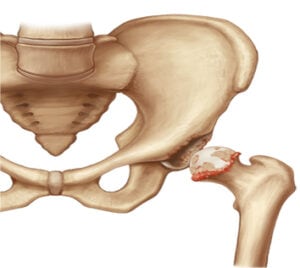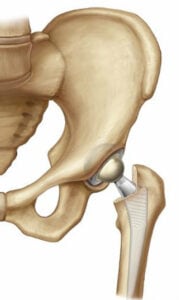Hip Anatomy and Arthritis
 Osteoarthritis is the most common form of arthritis and affects many people after middle age. It is often referred to a degenerative joint disease. There are many ways to treat arthritis to minimize pain, improve function, and provide quality of life.
Osteoarthritis is the most common form of arthritis and affects many people after middle age. It is often referred to a degenerative joint disease. There are many ways to treat arthritis to minimize pain, improve function, and provide quality of life.
Arthritis affects the cartilage, or smooth lining that covers the surfaces of the ball-and-socket hip joint. It is a very low friction interface that allows fluid motion in the normal hip. In the arthritic hip, the cartilage layer degenerates and can wear away, exposing the underlying bone. This may cause “Bone-on-bone Arthritis”. Cysts, or holes in the bone, and bone spurs called osteophytes may develop.
Causes of arthritis can be many. Sometimes previous injury or trauma causes wear. Abnormal alignment and motion can increase wear. Genetics may also play a role – patients with a strong family history of arthritis may be more likely to develop it themselves. In some cases, a condition called avasvcular necrosis can cause significant change and collapse of a joint when part of the bone dies.
Symptoms of arthritis usually include pain and loss of motion. Pain is the first sign for most patients. It can be associated with stiffness. At first, symptoms may only present with activity. As the disease progresses, patients may experience pain even at rest or at night.
The diagnosis of arthritis is made with a history and physical exam by your doctor. X-rays or other imaging may be performed to determine the extent of the damage and possibly the cause. If infection or other conditions such as Rheumatoid Arthritis are suspected, bloodwork or labs may be required.
Treatment of arthritis can usually begin with simple measures that your primary care physician may begin. These may include physical therapy and weight loss, over-the-counter medications or prescriptions, or assistive devices such as a cane or brace. Oftentimes injections can be helpful for an arthritic joint.
In some cases, surgery may be appropriate and necessary for the treatment of significant arthritis.
Hip Surgery
 Arthroscopy is an outpatient procedure that has relatively new indications for the hip. Through very small incisions, a surgeon can use a camera and small instruments to clean up an arthritic joint, remove some bone spurs, or repair certain types of cartilage injury. This is usually reserved for younger patients with less severe changes to their joint.
Arthroscopy is an outpatient procedure that has relatively new indications for the hip. Through very small incisions, a surgeon can use a camera and small instruments to clean up an arthritic joint, remove some bone spurs, or repair certain types of cartilage injury. This is usually reserved for younger patients with less severe changes to their joint.
Osteotomy is a procedure where the joint is realigned in the case of dysplasia, or abnormal anatomy or the hip. This can help to redistribute the forces across a joint and ease pain and slow the progression of arthritis. This is also a procedure usually reserved for younger patients and is a fairly large operation with significant recovery time.
Hip Replacement is a definitive solution for arthritis of the hip. In this procedure, both sides of the joint, the ball and socket are replaced with components that act just like a normal hip. All arthritic surfaces, and any parts that move on one another are resurfaced.
 Total hip replacement (THR) is the most common surgical procedure used to treat a patient with an arthritic hip. It can restore function and relieve pain associated with a significantly affected hip. In total hip replacement, both sides of the joint – the “ball and socket” are replaced. All arthritic surfaces, and any parts that move on one another are resurfaced.
Total hip replacement (THR) is the most common surgical procedure used to treat a patient with an arthritic hip. It can restore function and relieve pain associated with a significantly affected hip. In total hip replacement, both sides of the joint – the “ball and socket” are replaced. All arthritic surfaces, and any parts that move on one another are resurfaced.
While most patients who undergo total hip replacement are between ages 50 to 80, indications for surgery include both younger and older patients, depending on their pain and disability. People who need hip replacement surgery usually have problems walking, climbing stairs, and getting in and out of chairs. They may also experience moderate or severe hip pain at rest.
Recommendations for surgery are based on a patient’s pain and disability, not age. Total hip replacements have been successfully performed at all ages, from the teenager with juvenile arthritis to the elderly patient with degenerative arthritis.
In most cases, a total hip replacement becomes the best option when your arthritic hip causes so much pain that it interferes with your overall quality of life. For many patients, this means that the arthritis pain limits walking, standing, climbing stairs, or interferes with sleep.
During hip replacement, a surgeon removes damaged bone and cartilage from your thighbone (femur), hip socket (acetabulum) and replaces it with an artificial joint made of metal alloys and high-grade plastics or ceramics. In this procedure, both sides of the joint, the ball and socket are replaced with components that act just like a normal hip. All arthritic surfaces, and any parts that move on one another are resurfaced.
Direct anterior hip teplacement is a minimally invasive technique for total hip replacement that use a surgical approach through the front of the hip rather than the side or back. This approach avoids the need to cut or detach certain muscles of the hip that are important in normal activities.
The direct anterior approach utilizes a muscle interval in front of the hip joint in which muscles and tendons are not cut for exposure of the joint, which may differ from traditional approaches.
Dr. Harris performs this procedure in a supine position with computer and/or fluoroscopic imaging. This allows more precise positioning of the joint replacement and restoration of normal anatomy, decreasing the risk of unequal leg length or other component placement complications.
Because of this approach, there are several possible benefits, including less pain, less risk of dislocation, and faster initial recovery. No precautions or motion restriction are required after surgery. Most patients are discharged by post-operative day #2 and are able to come off of all assistive devices (cane or crutch) by the first follow-up visit.
Total Hip Replacement is an excellent procedure for the relief of hip pain due to arthritis, regardless of surgical approach, and the Direct Anterior Approach is not necessarily the best approach for all patients. Dr. Harris has extensive experience and fellowship training in all types of hip replacement and revision procedures. A thorough discussion will help determine which procedure is best for you.
